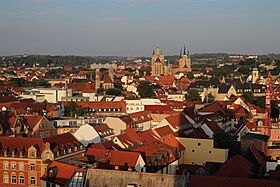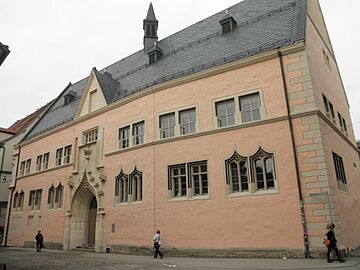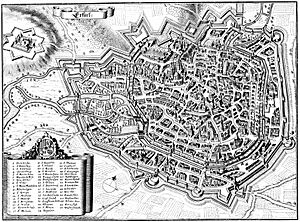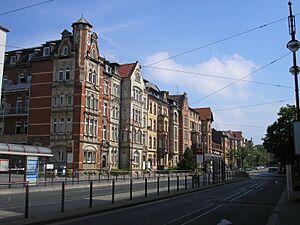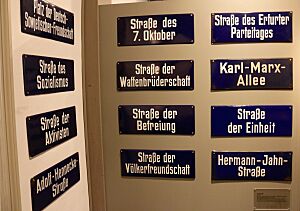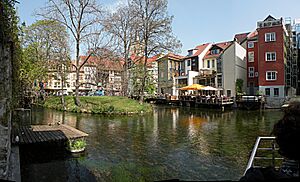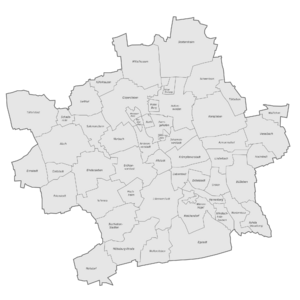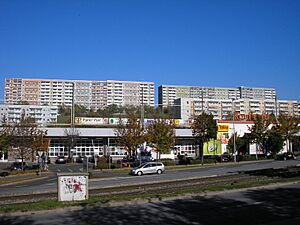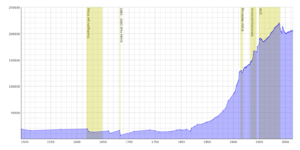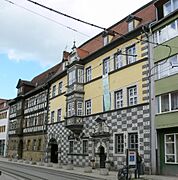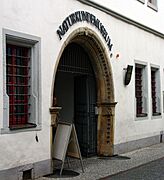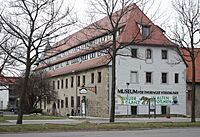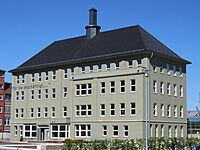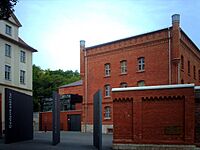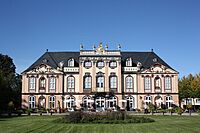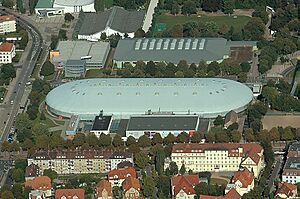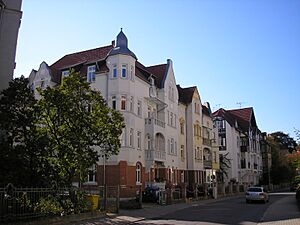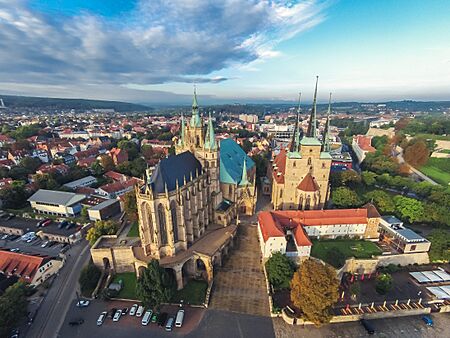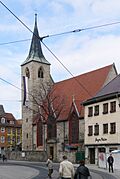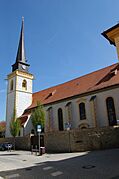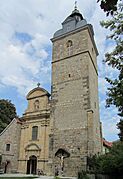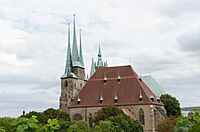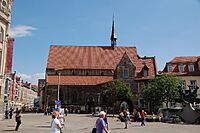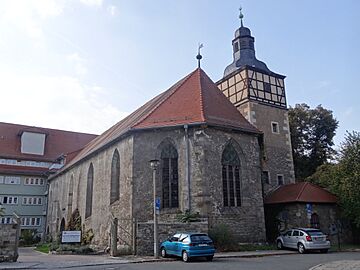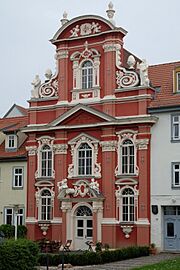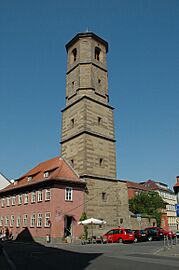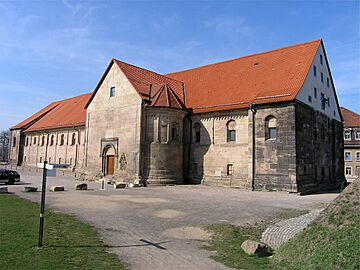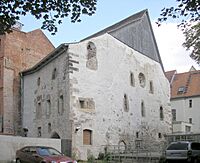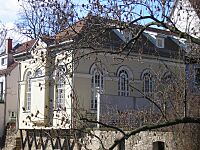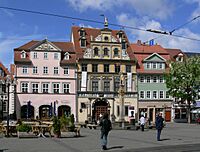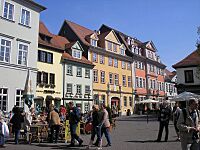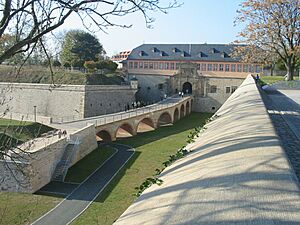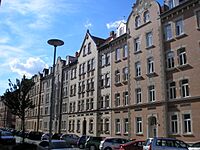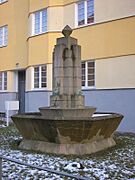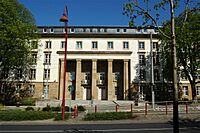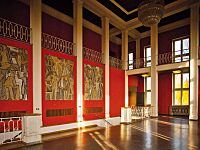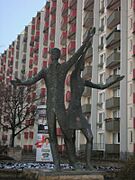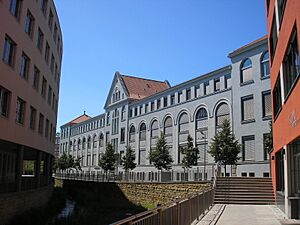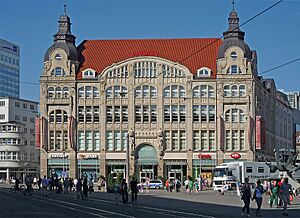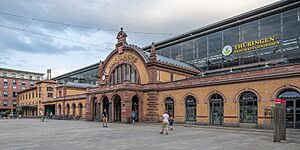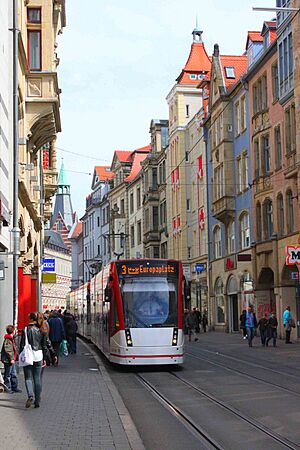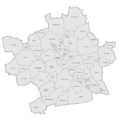Erfurt facts for kids
Quick facts for kids
Erfurt
|
|||
|---|---|---|---|
|
clockwise: view over the city, Merchants' Bridge (Krämerbrücke) from above, Merchants' Church (Kaufmannskirche), houses on Cathedral Square (Domplatz), Cathedral Hill (Domberg) with Erfurt Cathedral (Erfurter Dom) and St Severus' Church (Severikirche), Merchants' Bridge
|
|||
|
|||
| Country | Germany | ||
| State | Thuringia | ||
| District | Urban district | ||
| Founded | 1120 | ||
| First mentioned | 742 | ||
| Elevation | 194 m (636 ft) | ||
| Population
(2022-12-31)
|
|||
| • Total | 214,969 | ||
| Time zone | CET/CEST (UTC+1/+2) | ||
| Postal codes |
99084–99099
|
||
| Dialling codes | 0361 | ||
| Vehicle registration | EF | ||
| Official name: Jewish-Medieval Heritage of Erfurt | |||
| Type: | Cultural | ||
| Criteria: | iv | ||
| Designated: | 2023 | ||
| Reference #: | 1656 | ||
Erfurt is the capital and largest city in the German state of Thuringia. It's located in the wide valley of the River Gera. The city is in the middle of a line of six large Thuringian cities, stretching from Eisenach to Gera. Erfurt is close to the center of Germany.
Erfurt's old town is one of the best-preserved medieval city centers in Germany. Many tourists visit famous places like the Merchants' Bridge. The Old Synagogue is the oldest in Europe and a UNESCO World Heritage Site. You can also see Cathedral Hill (Domberg) with the impressive Erfurt Cathedral and St Severus' Church. Another highlight is Petersberg Citadel, a large and well-preserved town fortress. The city's economy relies on farming, gardening, and microelectronics. Because of its central spot, Erfurt is a major hub for shipping goods across Germany and Central Europe. It also hosts a big trade fair and is home to the public children's TV channel KiKa.
The city is on the Via Regia, an old trade and pilgrim route. Today, Erfurt is a key stop for fast ICE trains. Erfurt was first mentioned in 742 when Saint Boniface started a church area there. Even though it wasn't part of the Thuringian states, it quickly became important for trade. It was even a member of the Hanseatic League, a powerful group of trading cities. Later, it was part of the Electorate of Mainz and then the Kingdom of Prussia. From 1949 to 1990, Erfurt was part of German Democratic Republic (East Germany).
The University of Erfurt was founded in 1379, making it one of Germany's first universities. It closed in 1816 but reopened in 1994. Martin Luther (1483–1546), a very famous historical figure, studied here before becoming a monk. Other notable people from Erfurt include the philosopher Meister Eckhart and the composer Johann Pachelbel.
Contents
- Discovering Erfurt's Past
- Erfurt's Natural Setting
- People of Erfurt
- Culture and Sights
- Economy and Transportation
- Sister Cities
- Images for kids
- See also
Discovering Erfurt's Past
Early Times
West of Erfurt, in Frienstedt, archaeologists found a large Germanic village from ancient times. They even found the oldest Germanic word in Central Germany on a comb: "kaba". From Roman Times, over 200 coins and many Roman pottery pieces were discovered.
A dig in the southern part of the city, Melchendorf, showed a settlement from the neolithic period (New Stone Age). The Thuringii people lived in the Erfurt area around 480 AD, and the state of Thuringia is named after them.
Medieval Erfurt: A Trading Hub

The town was first mentioned in 742 as "Erphesfurt". Saint Boniface wrote to the Pope about starting a church area there. Archaeological finds show that the place was already busy with people.
During the Middle Ages, Erfurt was a very important trading town. It was located near a ford (a shallow place to cross) on the Gera river. Erfurt was a center for trading woad, a plant used to make blue dye. This trade made the city very rich. Important trade routes crossed here, connecting places like France, Russia, and even cities in Italy.
Over time, Erfurt gained more independence. Citizens started paying a "liberation tax" to become free. By 1217, the city had its own council, and a town hall was built in 1275. Erfurt grew into a strong regional power. In 1430, it joined the Hanseatic League, a powerful group of trading cities. By the 15th century, Erfurt had about 20,000 people, making it one of Germany's largest cities.
In 1184, a strange event happened in Erfurt called the Erfurter Latrinensturz (Erfurt latrine fall). King Henry VI was holding a meeting in a building near the Erfurt Cathedral. The floor collapsed because too many people were standing on it. Many people fell into the latrine pit below, but the King survived.
Erfurt had a thriving Jewish community from the 11th century. The Old Synagogue is still standing today and is a museum. In 1349, during a difficult time across Europe, many Jewish people in Erfurt faced persecution. Some were killed, and others were forced to leave the city. Before this, a wealthy Jewish merchant hid his treasures. This "Erfurt Treasure" was found in 1998 and is now displayed in the synagogue museum. A few years later, Jewish people returned to Erfurt and started a new community. In 2023, Erfurt's Jewish sites, including the Old Synagogue, became a UNESCO World Heritage Site.
The University of Erfurt was founded in 1379. It was one of the first universities in Germany owned by a city. It quickly became a center for learning and new ideas during the Renaissance humanism period.
Early Modern Period
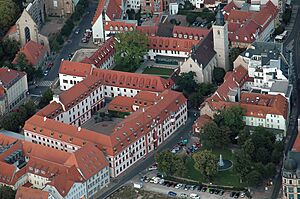
In 1501, Martin Luther (1483–1546) came to Erfurt to study at the university. From 1505 to 1511, he lived as a monk in St. Augustine's Monastery. Erfurt was one of the first cities to adopt the Protestant Reformation in 1521.
By 1530, Erfurt became one of the first cities in Europe to officially allow both Catholic and Protestant religions. However, the late 16th and 17th centuries saw a slow decline for Erfurt. Trade decreased, the population fell, and the university lost its influence. In 1664, the city came under the control of the Electorate of Mainz. A large fortress, Petersberg Citadel, was built to control the city.
In 1682 and 1683, Erfurt suffered greatly from the plague, with more than half the population dying. From 1526 to 1705, there were also some witch-hunts in Erfurt, where at least eight people died.
In the late 18th century, Erfurt had another cultural boom. Important writers and thinkers like Johann Wolfgang von Goethe and Friedrich Schiller often visited the city.
Erfurt and Napoleon
In 1802, Erfurt became part of the Kingdom of Prussia. However, in 1806, during the Napoleonic Wars, the city was taken over by the French army. Napoleon made Erfurt an "imperial state domain," meaning it was directly under his control. He visited the city several times. In 1808, the important Congress of Erfurt was held here, with Napoleon and Alexander I of Russia attending.
During French rule, new things like street lighting were introduced. However, some churches and buildings were damaged or had their contents sold off. Monuments to Napoleon were built, but they were later destroyed by the citizens when the French left.
After Napoleon's defeat in Russia, Erfurt was besieged by Prussian, Austrian, and Russian troops in 1813. The French troops eventually left the city in 1814. The monuments to Napoleon were destroyed by the people, showing their unhappiness with French rule. Many citizens of Erfurt died during the siege due to difficult conditions.
After the Congress of Vienna, Erfurt was returned to Prussia in 1815. It remained part of Prussia until 1944.
Modern Erfurt: Growth and Change
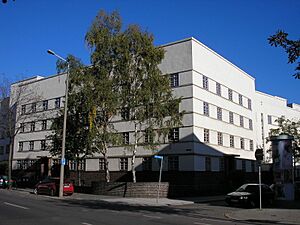
After the 1848 Revolution, many Germans wanted a united country. An attempt to create a German union in Erfurt in 1850 failed.
The Industrial Revolution came to Erfurt in the 1840s when the Thuringian Railway was built. Many factories opened, making things like engines, shoes, and guns. After Germany became united in 1871, Erfurt's city walls were no longer needed and were torn down. This led to a building boom, and the city grew rapidly. The population increased from 40,000 in 1870 to 130,000 by 1914.
The "Erfurt Program" was an important political plan adopted by the Social Democratic Party of Germany in 1891.
Between World War I and World War II, Erfurt continued to grow. New housing was built, and social services improved. However, the Great Depression in the early 1930s caused high unemployment. During the Nazi era, the new synagogue was destroyed in 1938 during the Kristallnacht (a night of violence against Jewish people). Jewish citizens lost their property and faced terrible persecution. The company Topf and Sons in Erfurt made crematoria for concentration camps. Today, there is a memorial and museum at their former factory to remember the victims of the Holocaust.
During World War II, Erfurt was bombed by British and American planes, and about 1,600 civilians died. The city was captured by US troops in 1945. Later, it became part of the Soviet Zone and then the German Democratic Republic (East Germany). In 1948, Erfurt became the capital of Thuringia. In the 1970s and 1980s, many old buildings in the city center decayed, and large apartment blocks were built on the city's edges.
On March 19, 1970, the leaders of East and West Germany met in Erfurt. This was the first such meeting since Germany was divided. The Peaceful Revolution of 1989-1990 led to German reunification.
After reunification, Erfurt became the capital of the re-formed state of Thuringia. Many factories closed, and people lost jobs. However, the city worked hard to rebuild. Old buildings were renovated, and infrastructure improved. The university reopened in 1994. Since 2005, the economy has improved, unemployment has decreased, and the population has started to grow again.
Erfurt's Natural Setting
City Landscape
Erfurt is in the south of the Thuringian basin, a rich farming area. This basin is located between the Harz mountains to the north and the Thuringian Forest to the southwest. The northern parts of the city are flat, while the southern parts have hills up to 430 meters high. The city has a municipal forest called Steigerwald with many beech and oak trees. The Gera river flows through the city, forming a basin.
Weather in Erfurt
Erfurt has a climate with warm summers and relatively cold winters. Summer high temperatures average around 23°C (73°F), and winter lows average around -3°C (27°F). The city's location in a basin can sometimes lead to very cold nights in winter and less air movement in summer. Erfurt gets about 535 mm (21 inches) of rain each year, spread out throughout the year. Snowfall is light and usually doesn't stay long.
| Climate data for Erfurt (Erfurt–Weimar Airport) (1991–2020 normals, extremes since 1951) | |||||||||||||
|---|---|---|---|---|---|---|---|---|---|---|---|---|---|
| Month | Jan | Feb | Mar | Apr | May | Jun | Jul | Aug | Sep | Oct | Nov | Dec | Year |
| Record high °C (°F) | 15.8 (60.4) |
19.0 (66.2) |
24.2 (75.6) |
29.6 (85.3) |
31.4 (88.5) |
35.9 (96.6) |
37.6 (99.7) |
36.3 (97.3) |
31.6 (88.9) |
26.6 (79.9) |
20.8 (69.4) |
17.4 (63.3) |
37.6 (99.7) |
| Mean daily maximum °C (°F) | 2.7 (36.9) |
4.1 (39.4) |
8.4 (47.1) |
13.8 (56.8) |
17.7 (63.9) |
21.1 (70.0) |
23.6 (74.5) |
23.6 (74.5) |
18.7 (65.7) |
13.1 (55.6) |
7.2 (45.0) |
3.6 (38.5) |
13.1 (55.6) |
| Daily mean °C (°F) | 0.2 (32.4) |
0.9 (33.6) |
4.3 (39.7) |
8.8 (47.8) |
12.9 (55.2) |
16.1 (61.0) |
18.3 (64.9) |
18.1 (64.6) |
13.8 (56.8) |
9.1 (48.4) |
4.4 (39.9) |
1.2 (34.2) |
9.0 (48.2) |
| Mean daily minimum °C (°F) | −2.5 (27.5) |
−2.3 (27.9) |
0.3 (32.5) |
3.5 (38.3) |
7.4 (45.3) |
10.8 (51.4) |
12.8 (55.0) |
12.7 (54.9) |
9.1 (48.4) |
5.4 (41.7) |
1.6 (34.9) |
−1.4 (29.5) |
4.8 (40.6) |
| Mean minimum °C (°F) | — | — | — | — | — | — | — | — | — | — | 1.6 (34.9) |
— | 1.6 (34.9) |
| Record low °C (°F) | −25.0 (−13.0) |
−24.6 (−12.3) |
−20.2 (−4.4) |
−10.4 (13.3) |
−2.9 (26.8) |
0.0 (32.0) |
3.3 (37.9) |
3.8 (38.8) |
−0.6 (30.9) |
−7.6 (18.3) |
−18.6 (−1.5) |
−23.5 (−10.3) |
−25.0 (−13.0) |
| Average precipitation mm (inches) | 25.0 (0.98) |
22.9 (0.90) |
36.3 (1.43) |
34.2 (1.35) |
63.9 (2.52) |
55.7 (2.19) |
80.8 (3.18) |
58.7 (2.31) |
45.8 (1.80) |
37.6 (1.48) |
41.1 (1.62) |
32.6 (1.28) |
534.7 (21.05) |
| Average precipitation days (≥ 0.1 mm) | 15.0 | 13.1 | 14.8 | 11.8 | 13.8 | 13.2 | 14.9 | 13.0 | 12.0 | 13.9 | 14.3 | 15.3 | 165.0 |
| Average snowy days (≥ 1.0 cm) | 11.7 | 9.5 | 4.3 | 0.3 | 0 | 0 | 0 | 0 | 0 | 0.2 | 2.0 | 7.3 | 35.4 |
| Average relative humidity (%) | 85.7 | 82.4 | 77.7 | 70.7 | 72.1 | 72.4 | 70.1 | 69.2 | 76.2 | 82.8 | 87.0 | 87.2 | 77.8 |
| Mean monthly sunshine hours | 59.7 | 80.6 | 128.7 | 184.8 | 211.9 | 219.8 | 224.7 | 210.4 | 159.3 | 112.4 | 60.7 | 47.0 | 1,706.5 |
| Source 1: NOAA | |||||||||||||
| Source 2: Infoclimat | |||||||||||||
City Districts
Erfurt is divided into 53 districts. The city center is called Altstadt (old town). Around it are districts like Andreasvorstadt and Johannesvorstadt. Some areas like Ilversgehofen used to be industrial. Other districts, such as Berliner Platz and Melchendorf, have many Plattenbau (prefabricated) apartment buildings built during the East German period.
Many villages were added to Erfurt during the 20th century. They still feel like small rural communities.
Erfurt-Southeast: A Look at Modern Housing
Erfurt-Southeast is a group of housing areas built in the last ten years of East Germany. It's the second-largest area of prefabricated buildings in the city. The districts of Melchendorf, Herrenberg, and Wiesenhügel are part of Erfurt-Southeast. About 24,000 people live in this large settlement.
People of Erfurt
| Nationality | Population |
|---|---|
| Ukraine | 3,596 |
| Syria | 2,315 |
| Poland | 2,025 |
| Hungary | 1,435 |
| Vietnam | 1,252 |
| Italy | 1,143 |
| Romania | 1,014 |
| Afghanistan | 955 |
| Bulgaria | 943 |
| Serbia | 737 |
Around 1500, Erfurt had 18,000 people, making it one of the largest cities in the Holy Roman Empire. The population grew slowly until the 19th century. After the railway arrived in 1847, the population increased quickly, reaching 130,000 by World War I. In 1988, it reached its highest point with 220,000 people.
After German reunification in 1991, the population dropped due to economic changes. However, it started to rise again after 2002. Today, Erfurt is a popular city in former East Germany, partly because of its universities.
About 3% of Erfurt's population are non-German citizens. Many people in Erfurt are not religious, partly due to the former socialist government's policies. About 14.8% are Protestant, and 6.8% are Catholic. The Jewish community has about 500 members, many of whom moved from Russia and Ukraine in the 1990s.
Culture and Sights
Famous People from Erfurt's History
- The philosopher Meister Eckhart (c. 1260–1328) lived in a monastery in Erfurt.
- Martin Luther (1483–1546) studied law and philosophy at the University of Erfurt. He also lived as a monk in St Augustine's Monastery.
- Johann Pachelbel (1653–1706), a famous Baroque composer, was an organist at the Predigerkirche church in Erfurt.
- The city is the birthplace of Johann Bernhard Bach, a cousin of Johann Sebastian Bach. Johann Sebastian Bach's parents were married in the Merchants' Church in Erfurt.
- Max Weber (1864–1920), a very important sociologist, was born in Erfurt.
- The textile designer Margaretha Reichardt (1907–1984), who studied at the Bauhaus art school, was born and died in Erfurt. Her former home is now a museum.
- Modern musicians like Clueso and Yvonne Catterfeld are also from Erfurt.
Museums to Explore
Erfurt has many interesting museums:
- The Stadtmuseum (municipal museum) tells the story of Erfurt, focusing on the Middle Ages and Martin Luther.
- The Alte Synagoge (Old Synagogue) is one of Europe's oldest synagogues. It's now a museum about local Jewish history and displays the Erfurt Treasure.
- The Erinnerungsort Topf & Söhne (Topf and Sons memorial) is at the factory site that built crematoria for concentration camps. It teaches about the company's role in the Holocaust.
- Memorial and Education Centre Andreasstrasse (Stasi Museum) is at a former secret police prison. It shows what life was like in East Germany.
- The Angermuseum is an art museum focusing on modern art and medieval sculptures.
- The Kunsthalle Erfurt (Erfurt City Art Gallery) shows contemporary art.
- The Margaretha Reichardt Haus is the home and workshop of textile designer Margaretha Reichardt.
- The Deutsches Gartenbaumuseum (German Horticulture Museum) is located in the Cyriaksburg Citadel.
- The Naturkundemuseum (Natural History Museum) explores Thuringian plants, animals, and geology.
- The Museum für Thüringer Volkskunde (Museum of Folk Art) shows the daily life and traditions of people in Thuringia.
- The Elektromuseum (Museum of Electrical Engineering) shows the history of electric engines.
- Schloss Molsdorf is a Baroque palace with an art exhibition.
Image Gallery of Museums
Theatre and Sports
Since 2003, the modern opera house has been home to Theater Erfurt and its orchestra. It has a large stage with 800 seats.
Erfurt is home to the Oettinger Rockets, a professional basketball team. Popular sports in Erfurt include athletics, ice skating, cycling (with the world's oldest velodrome, opened in 1885), swimming, and football. The city's football club is FC Rot-Weiß Erfurt. The Gunda-Niemann-Stirnemann Halle is an indoor speed skating arena.
Erfurt's Cityscape and Architecture
Erfurt's city center has narrow, winding alleys from medieval times. Around this core is a belt of buildings from the Gründerzeit era (1873-1914). After the city walls were removed in 1873, new houses were built rapidly. Different areas had different types of housing, from workers' apartments to wealthy mansions.
Between the World Wars, some housing in the Bauhaus style was built. After World War II, large Plattenbau (prefabricated) housing areas were constructed on the city's edges. After reunification, many old houses in the city center were restored.
Erfurt was not heavily damaged in World War II, so its center has a mix of medieval, Baroque, and Neoclassical architecture, along with newer buildings. The city has many green spaces, including parks like Stadtpark and the large Egapark, a horticultural exhibition park.
Churches, Monasteries, and Synagogues
The city center has about 25 churches and monasteries, mostly in Gothic style. Their many steeples give Erfurt the nickname "Thuringian Rome."
Catholic Churches and Monasteries
- The Allerheiligenkirche (All Saints' Church) is a 14th-century Gothic church.
- The Dom St. Marien (St Mary's Cathedral) is the main cathedral and a major sight. It has a mix of Romanesque and Gothic styles and the world's largest free-swinging medieval bell, named Gloriosa.
- The Lorenzkirche (St Lawrence's Church) is a small 14th-century Gothic church.
- The Martinikirche (St Martin's Church) was built in the 15th century and later changed to Baroque style.
- The Neuwerkskirche St. Crucis (Holy Cross Church) is a 15th-century Gothic church.
- The Schottenkirche St. Nikolai und St. Jakobi (Scots Monks' Church) is an 11th-century Romanesque church with a Baroque front.
- The Severikirche (St Severus' Church) is the second-largest parish church and stands next to the cathedral. It's in Gothic style.
- The Ursulinenkirche, St Ursula's Church, is a Gothic church connected to the Ursulinenkloster, St Ursula's Nunnery. This nunnery has been active since 1136.
- The Wigbertikirche (St Wigbert's Church) is a 15th-century Gothic church.
Protestant Churches and Monasteries
- Ägidienkirche (St Giles' Church) is a 14th-century Gothic church at the end of the Merchants' Bridge. You can climb its steeple for a great view.
- Andreaskirche (St Andrew's Church) is a 14th-century Gothic church in the old craftsmen's quarter.
- Augustinerkloster (St Augustine's Monastery) dates from 1277. Martin Luther lived here as a monk. Today, it's a place of worship and a meeting center.
- The Kaufmannskirche St. Gregor (Merchant's Church of St Gregory) is a 14th-century Gothic church. Johann Sebastian Bach's parents were married here.
- Michaeliskirche (St Michael's Church) is a 13th-century Gothic church that became the university church. Erfurt's first Protestant sermon was preached here.
- The Predigerkirche (Dominican Church) is a Gothic monastery church. It's the main Protestant church in Erfurt. The philosopher Meister Eckhart and composer Johann Pachelbel were connected to this church.
- The Reglerkirche St. Augustinus (Regulated St Augustine's Church) is a 12th-century Romanesque-Gothic church.
Former Churches and Their Remains
- The Barfüßerkirche was a 14th-century Gothic church. It was badly damaged in 1944, and its ruins are now a war memorial.
- The Bartholomäuskirche (St Bartholomew's Church) was a Gothic church. Only its steeple remains, which now holds a carillon (a set of bells).
- The Hospitalkirche (Hospital Church) was a 14th-century Gothic building, now used by a museum.
- The Peterskirche (St Peter's Church) was built in the 12th century. It was used as a military storehouse and now houses an art gallery.
Synagogues: A Rich Jewish History
Erfurt's Alte Synagoge (Old Synagogue) has parts dating back to the 11th century. It was used until 1349 when the Jewish community faced a difficult time. The building was later used for other purposes but was restored and became a museum in 2009. It displays the Erfurt Treasure. A rare Mikveh, a ritual bath from around 1250, was found in 2007 and can be visited. In 2023, Erfurt's Jewish heritage sites, including the Old Synagogue and Mikveh, became a UNESCO World Heritage Site.
When religious freedom was allowed again, Jewish people returned to Erfurt. They built the Kleine Synagoge (Small Synagogue) in 1840, which is now an event center. A larger synagogue, the Große Synagoge (Great Synagogue), was built in 1884 but was destroyed during the Kristallnacht in 1938.
The current Neue Synagoge (New Synagogue) opened in 1952 on the same land. It was the only synagogue built in East Germany under communist rule.
Historic Buildings and Squares
Erfurt has many historic non-religious buildings, mostly in the city center.
Streets and Squares to See
- The Krämerbrücke (Merchants' Bridge) is Erfurt's most famous sight. This 15th-century bridge has houses built all along it, which is very rare in Europe. Today, these houses have craft and souvenir shops.
- The Domplatz (Cathedral Square) is Erfurt's largest square. The cathedral and St Severus' Church stand on one side, reached by wide stairs. The square is surrounded by old houses and is a popular spot for the Christmas Market and open-air theater.
- The Fischmarkt (Fish Market) is the central square, surrounded by old houses and the Neo-Gothic town hall. A statue called Römer (Roman) symbolizes the city's independence.
- The Wenigemarkt (Minor Market) is a smaller square with cafes and bars. Nearby is the Kaisersaal, a historic event hall where the Congress of Erfurt took place in 1808.
- The Anger is a long square in the eastern city center. It's a busy hub with many important buildings like the main post office, the Martin Luther monument, and the Angermuseum.
- The Willy Brandt Square is in front of the main train station. The former hotel Erfurter Hof here was where the leaders of East and West Germany first met in 1970.
- The Hirschgarten (Deer Garden) is a small park in front of the Thuringian government building.
- The Michaelisstraße (Michael's Street) is known as "the stone chronicle of Erfurt" because of its many medieval buildings. It's a popular area for nightlife.
- The Juri-Gagarin-Ring is a circular road that follows the path of the old city wall.
- The Andreasviertel (St Andrew's Quarter) is an old craftsmen's quarter with narrow alleys and small, historic houses.
Fortifications: Protecting the City
From 1066 until 1873, Erfurt was surrounded by a fortified wall. After Germany united in 1871, the walls were no longer needed and were mostly taken down. Only a few parts of the wall remain today.
The Petersberg Citadel is one of Europe's largest and best-preserved city fortresses. It covers 36 hectares and was used by the military until 1963. Now, it's a historic site open to the public.
The Cyriaksburg Citadel is a smaller citadel from 1480. It now houses the German horticulture museum.
Architecture from the 19th and 20th Centuries
Between 1873 and 1914, many Gründerzeit style buildings were built around the city center. The mansion district in the southwest has beautiful Gründerzeit and Art Nouveau buildings.
The "Mühlenviertel" ("mill quarter") has lovely Art Nouveau apartment buildings and cobblestone streets. This area used to have many water mills.
The Bauhaus style is seen in some housing projects. Lutherkirke Church (1927) is an Art Deco building.
The former "Wolff" malt factory is a large industrial complex built between 1880 and 1939. It's sometimes used for movie productions.
Examples of Nazi-era architecture include the Thuringian parliament building and the Thüringenhalle event hall.
The early East German (GDR) style is seen in the main university building. Later GDR style is shown in the Egapark and the Plattenbau housing complexes.
Modern architecture, with glass and steel, is used for newer buildings like the Federal Labour Court, the new opera house, and the main train station.
Economy and Transportation
Jobs and Industries
Erfurt's economy has improved in recent years. The unemployment rate has gone down.
Farming has a long history in Erfurt. Growing woad (for blue dye) made the city rich long ago. Today, gardening and producing flower seeds are still important. Fruits, vegetables, and grain are also grown.
Industrial growth began around 1850. Factories made engines, shoes, guns, and electronics. After 1945, under East German rule, many companies were taken over by the government. After reunification, most factories closed. However, the government helped start new companies. Today, Erfurt has many small and medium-sized businesses, focusing on electronics, semiconductors, and solar power. Engine production, food production, and local breweries are also important.
Erfurt is a major service center in Germany. It's the capital of Thuringia, so it has many government offices. It's also a hub for logistics, with many distribution centers. The Erfurt Trade Fair and media companies like KiKa and MDR are also important. Tourism is growing, with many visitors coming to see Erfurt's historic sights. The Christmas Market attracts millions of visitors each year.
Getting Around Erfurt
By Train
Erfurt is well-connected by ICE high-speed trains. You can reach Berlin in 1.5 hours, Frankfurt in 2.5 hours, and Munich in 2.5 hours. Regional trains connect Erfurt to many nearby cities. There's also a freight transport terminal for goods.
By Road
Two major highways, the Bundesautobahn 4 (Frankfurt–Dresden) and the Bundesautobahn 71 (Schweinfurt–Sangerhausen), cross near Erfurt. These highways form a ring road around the city. Some parts of the inner city are for pedestrians only.
By Tram and Bus
Erfurt has a wide-ranging light rail (tram) network, which was updated in 1997. There are six tram lines running frequently. The city also has a bus system that connects outer districts to the city center.
By Airplane
Erfurt-Weimar Airport is just 3 km (2 miles) west of the city center. It has flights to holiday destinations and London during the Christmas market season. For longer flights, you can easily reach Frankfurt Airport or Leipzig/Halle Airport by train.
By Bike
Biking is popular in Erfurt, with many high-quality bike paths. There are local bike lanes for daily travel. Long-distance trails like the Gera track and the Radweg Thüringer Städtekette (Thuringian cities trail) are great for tourists. The Rennsteig Cycle Way, about 200 km (124 miles) long, follows a historic hiking trail.
Learning in Erfurt
After German reunification, Erfurt's education system was reorganized.
- The University of Erfurt, which closed in 1816, reopened in 1994. It focuses on social sciences, languages, humanities, and teacher training. It has about 6,000 students and an international reputation.
- The Fachhochschule Erfurt is a university of applied sciences founded in 1991. It offers practical training in subjects like social work, business, and engineering. It has nearly 5,000 students.
- The International University of Applied Sciences Bad Honnef – Bonn (IUBH) is a private university for business and economics.
- The famous Bauhaus design school was founded nearby in Weimar.
- Erfurt also has eight Gymnasien (high schools), including special schools for sports and sciences.
Media and News
- The German national public television children's channel KiKa is based in Erfurt.
- MDR, Mitteldeutscher Rundfunk, a radio and television company, has studios in Erfurt.
- The Thüringer Allgemeine is a statewide newspaper headquartered in the city.
Sister Cities
Erfurt is twinned with several cities around the world:
Images for kids
See also
 In Spanish: Érfurt para niños
In Spanish: Érfurt para niños


